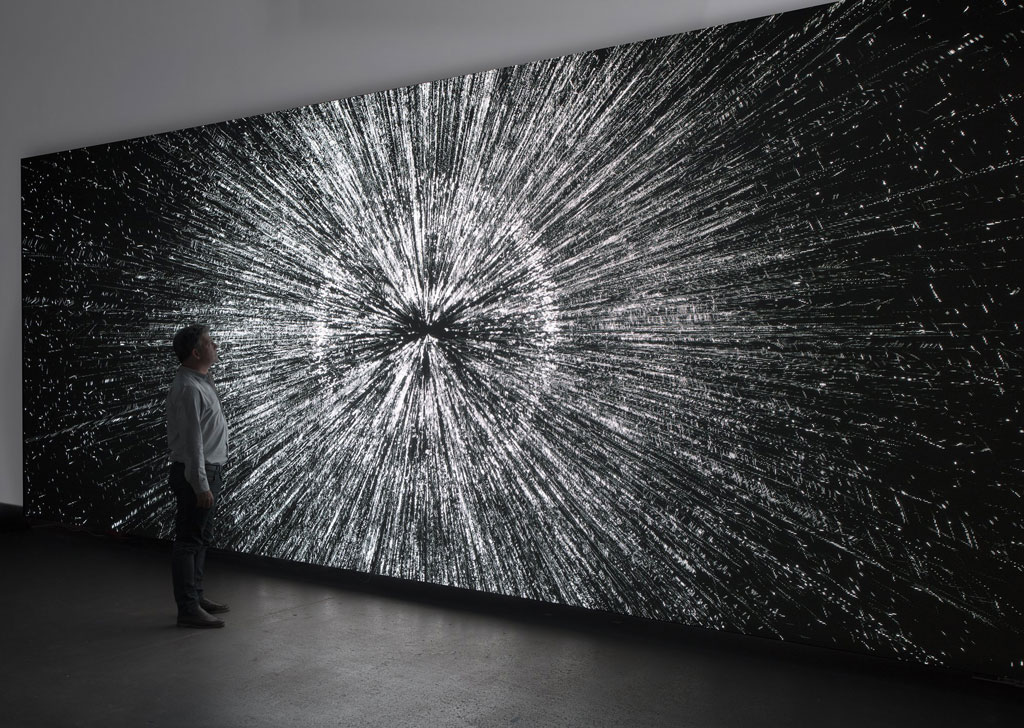ART CITIES:London-Leo Villareal
 Leo Villareal works with LED lights to create complex, rhythmic artworks for both gallery and public settings. He focuses on identifying the governing structures of systems and is interested in base units such as pixels and binary code. His installations use artist-created code, which constantly changes the frequency, intensity, and patterning of lights through sequencing.
Leo Villareal works with LED lights to create complex, rhythmic artworks for both gallery and public settings. He focuses on identifying the governing structures of systems and is interested in base units such as pixels and binary code. His installations use artist-created code, which constantly changes the frequency, intensity, and patterning of lights through sequencing.
By Efi Michalarou
Photo: Pace Gallery Archive
Leo Villareal’s solo exhibition in London coincides with the recent launch of Villareal’s “Illuminated River”*, a major public artwork that, upon completion, will illuminate 14 bridges along the Thames. For his exhibition Villareal expands these legacies across a body of new and recent work, which include three new LED works of varying scales alongside six single-panel pieces from the “Instance” series (2018), as well as “Corona” (2018), a triptych of OLED screens. The works expand upon the artist’s fascination with visualizing systems, both their operation and disruption, through the phenomenal properties of light. At the center of the exhibition is “Detector” (2019), a monumental work that spans over 10 metres and features undulating fields of patterned luminescence, suggesting the sifting of stars, galaxies, and other astral phenomena. Signals penetrate through fields of noise as clusters of particles expand and collide, conjuring antipodal forms from the cosmic to the atomic. Two works flank “Detector” titled “Optical Machine I & II”, and serve as portals into the visual manifestation of Villareal’s rule-based software, which engages chance through the concepts and computational techniques of artificial life and emergent behaviour. Employing a highly synthetic process, Villareal’s works nevertheless echo the ubiquitous systems that produce organic behaviors found throughout nature. The 6 pieces from Villareal’s “Instance” series function both as individual artworks and as part of an orchestrated whole. For the exhibition, the artist has networked together two groups of 3 works from the series, allowing the individual panels to act alone while at times performing in synchronicity with interconnected works. Existing simultaneously as both standalone objects and nodes in a larger system, the works convey the interdependence between their digital and physical forms while incorporating new levels of complexity in their visual behavior. Linked together, they produce malleable synchronies wherein the possibility of order, however fleeting and subtle, flashes briefly into existence before gradually dissipating into a state of entropy. “Corona” is composed of three 4K OLED screens that display animated particles rhythmically pulsing in radial choreographies. Villareal’s use of the triptych underscores the importance of art-historical precedent in his work, alluding to a format originally associated with Renaissance altarpieces, but which recurs throughout the history of painting. “Corona” explores how the traditional form of the triptych takes on new meaning in contemporary digital age, in which screens proliferate around us in increasingly immersive configurations. The range of Villareal’s formats spans the possibilities of current technology. The high-resolution OLED screen array in “Corona” contains 24,883,200 pixels, whereas the LED panel works feature a drastically reduced pixel pitch. By embracing a technology with reduced visual complexity, Villareal emphasizes the actual binary unit of each lightemitting diode, rooting the works in the materiality of mechanical reproduction and the discrete visual marks that comprise the substrate of printmaking.
* The Illuminated River is a design commission on an unprecedented scale: a scheme to light central London’s bridges along the River Thames. An international design competition was held in 2016 to find the best creative responses for lighting Central London’s bridges. The winning submission, by Leo Villareal and British architects, Lifschutz Davidson Sandilands (LDS), will be a kinetic lighting artwork that will unify and illuminate the bridges for 20 years. Once complete, this will be the longest permanent public art commission in the world more than 4 km in length.
Info: Pace Gallery, 6 Burlington Gardens, London, Duration: 22/11/19-18/1/20, Days & Hours: Tue-Sat 10:00-18:00, www.pacegallery.com
